Looking for the best things to do in Madrid? As a major cultural capital of Europe, Madrid has its fair share of world-class attractions. Here’s our guide to the very best experiences and sights in Madrid.
By: Paul Healy | Last Updated: | Jump to Comments
We’re lucky enough to spend a lot of time in Spain. In our downtime away from writing this blog, researching trips and travelling, we love to head down to Spain to relax and catch some sun.
It’s often where we feel like we’re actually taking a break from work. And, while we love nothing better than doing nothing on Spain’s beaches, Madrid is something of an unlikely escape for us.
Tourism is not Madrid’s main industry, so it feels like you’re in a real city, rather than somewhere that’s putting on a show for visitors, which is strange, because Madrid is full of majestic regal landmarks.
Yet somehow the grandeur of the Royal Palace, the elegance of the Grand Vía, or the splendour of Plaza Mayor, does nothing to detract from Madrid’s relaxed vibe.
Madrid is a great place to hang out. We love coming here, and our aim with this guide is to inspire you to feel the same way.
We cover all the main attractions that you wouldn’t want to miss. But we’ve also included some ways you can experience the relaxed local side of Madrid.

MAP: THINGS TO DO IN MADRID
Most of Madrid’s main attractions are located in the central district, including landmarks such as the Royal Palace of Madrid, the Plaza Mayor, the Gran Vía, and the Mercado de San Miguel, as well as the Prado Museum, the Reina Sofia Museum and the Thyssen-Bornemisza Museum.
The map below contains all the Madrid attractions listed in this guide.
USING OUR MAPS. Click on the top right corner to open in the Google Maps app. Click on the star to save to your Google account.
WHAT TO DO IN MADRID?
There’s no shortage of great things to do in Madrid. But if we had to pick, these are the attractions we think you really shouldn’t miss.
1. ROYAL PALACE (PALACIO REAL)
Madrid’s grandest building, the Palacio Real, was constructed on the orders of King Phillip V.
The palace that stands today has over 3,000 rooms and, by some sources, it’s considered the largest royal palace in Europe. The floor space is over 135,000 square feet.
The palace is the official home of the Spanish royal family. It’s bursting with art from artists including Caravaggio, Goya, and Velázquez.
Some of our highlights were:
- The Throne Room – the vaulted ceiling contains a stunning fresco depicting the royal family.
- Salón de Columnas – a ballroom with incredible Belgian tapestries.
- Escalera Principal – the main staircase with an imposing sculpture of Charles II.
- Gasparini Salon – private dressing room of Carlos II and one of the most beautiful rooms in the palace.
Tickets – The palace can get very busy, with long queues, so buy a fast-track ticket and arrive as early as possible.



2. LA ALMUDENA CATHEDRAL
Construction began on the Almudena Cathedral in 1883 but it wasn’t completed until 1992.
The large, cavernous space is unusual for a cathedral. A vivid colourful ceiling and stained glass windows feature a design of straight lines and geometric patterns.
It lacks the charm of other European cathedrals such as the Sienna Cathedral or the incredible Granada Cathedral, but it’s worth popping in for a quick look.
What we definitely think you should do, however, is visit the Cathedral Crypt.

3. CATHEDRAL CRYPT (ST MARY ROYAL OF THE ALMUDENA)
While the cathedral might be lacking in aesthetic appeal, the crypt (Parroquia Santa la Real de la Almudena) was one of the highlights of our last trip to Madrid.
It has the same dimensions as the cathedral, supported by 500 columns decorated with arches and elaborate reliefs. The effect of rows and rows of columns, lit from below, is mesmerising.
The crypt also has 5 naves, 20 chapels, and beautiful Gothic-style-stained glass windows. It’s slightly hidden from the main cathedral and often overlooked so you might find there are few people here.
The entrance to the crypt is located on the south side of the cathedral on Calle Mayor.
Tickets – The crypt is free to enter, but it’s worth getting the audio guide €1.50). Check opening times on the official website.



4. PLAZA MAYOR
Plaza Mayor, Madrid’s grand central square, is the oldest part of the city. It’s the perfect central landmark to orient yourself when exploring the city.
The square was destroyed by fire in 1790. The current design utilises architectural uniformity to create grand space.
Cafes overlook the square from shaded porticos but we’d give these a miss. It’s a very touristy part of the city so you’ll find lots of souvenirs on sale.
As with many European main squares, you’ll find street performers, artists, outdoor concerts, and parades, depending on the time of year you’re visiting.
The highlights are the Arco de Cuchilleros – the most monumental of the 9 arches leading to the square. The Statue of Philip III by Flemish sculptor Giambologna is also impressive.
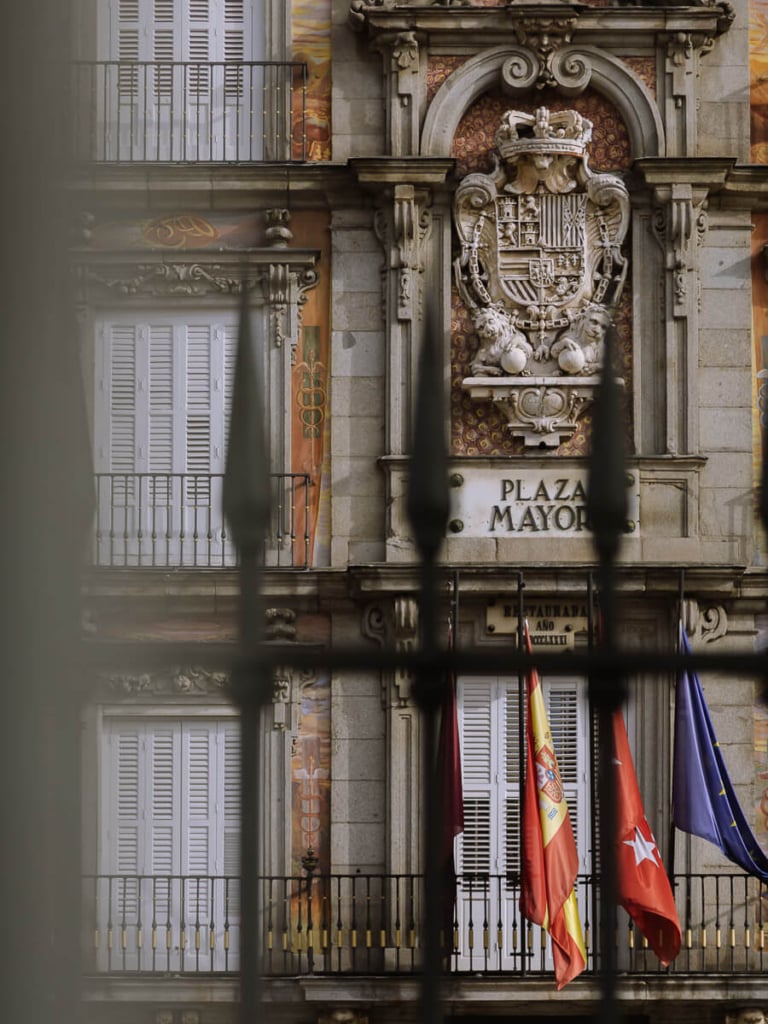

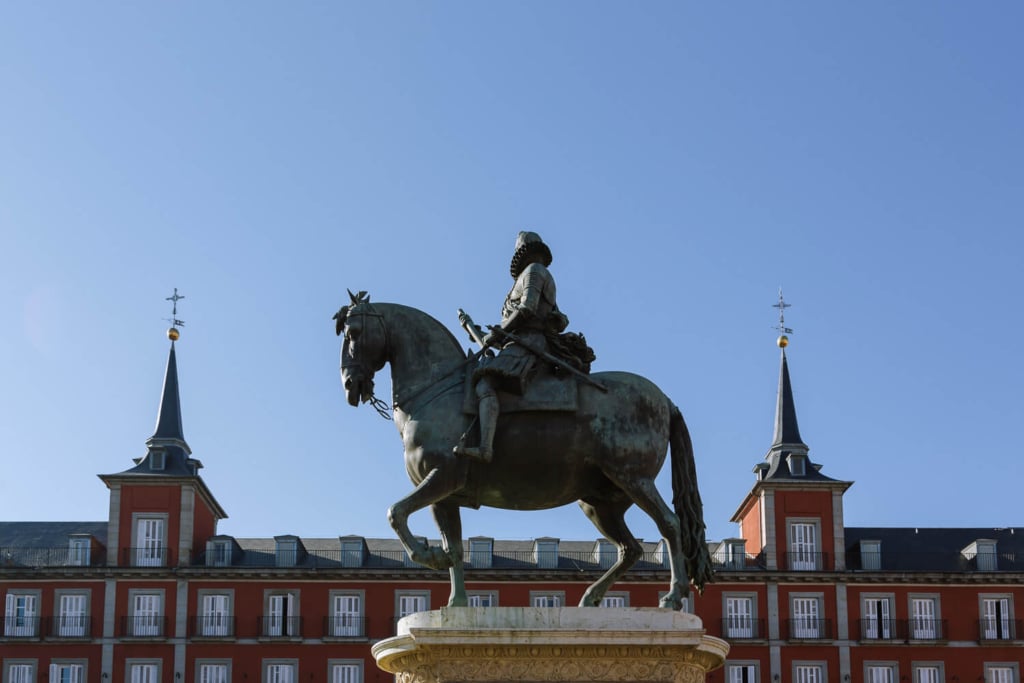

5. CHURROS AT SAN GINÉS
Churros and chocolate is a Spanish treat and something you can’t leave Madrid without trying.
Spaniards generally have churros over the winter months, because it’s considered a warming treat. However, Chocolatería San Ginés is open throughout the year, 24 hours a day, so you can consume them whenever you please.
San Ginês is famous for having some of the best churros in Spain. They’ve been going for 120 years and the traditional recipe hasn’t changed since. Their chocolate is rich and dense and it’s a real treat.

6. SAN MIGUEL MARKET
The San Miguel Market is a beautiful cast-iron structure dating back to 1916.
After several reincarnations, the most recent version relaunched in 2018 and it has some of the finest produce from across Spain.
You’ll find everything from delicious tapas to the freshest seafood; unusual Spanish ice cream flavours, paella, cheeses and breads.
It can get very busy at lunch so make sure you find a table and secure it, before heading to the stalls to order your food.
Chocolala Belga – Don’t miss Chocolala Belga on Calle del Bonetillo, just around the corner from the market. The owner, Paul-Hector Bossier crafts incredible Belgian chocolates.




7 – TEMPLE OF DEBOD & PLAZA DE ESPAÑA
The Temple of Debod is an ancient Egyptian temple that was dismantled and rebuilt in Parque de la Montaña, Madrid.
The Egyptian government donated it for preservation, and it’s one of the few examples of Egyptian architecture outside the country.
Surrounded by a pool of water with views over the palace, it is a nice photo opportunity, but you don’t need long to check it out.
The nearby Plaza de España has recently been renovated to create a greener, more accessible tourist attraction within the city. This revamped space is now car-free with walking and cycling tracks that connect it to other green spaces in Madrid.


8. ERMITA DE SAN ANTONIO DE FLORIDA
The Chapel of St Anthony of La Florida is a small but beautiful chapel in the centre of Madrid. The highlight is the stunning frescoes by Francisco Goya.
Goya is considered one of Spain’s most important artists from the late 18th and early 19th centuries. His work reflects historical and political upheavals.
He is buried in the church which acts as a fitting canvas for some of his finest works.
It’s just a single room in an unassuming building but it contains world-class art.
Unfortunately, photos are not permitted inside, so you’ll have to go and see for yourself the treasures that it holds.

9. MALASAÑA DISTRICT
Malasaña is a bohemian district in Madrid with cool shops, restaurants, cafes, bars, and markets. It’s a great part of the city to explore, and the best way to experience it is to stroll around aimlessly soaking up the ambience.
The ground floors of the buildings contain tattooists, bakeries, fishmongers, boutiques and bars. Upstairs is residential accommodation.
The result is a lived-in area, slightly worn around the edges and bursting with character.
Here are some of our favourite places in Malasańa –
- HanSo Café – A relaxed coffee house with a great selection of sandwiches and excellent coffee.
- Plaza Juan Pujol – A colourful square with student-centred cafes and street art, it’s a cool place to hang out when you need a break.
- Toma Café – This great little café for speciality coffee, cakes, and pastries, has one of the best tomato and bread in Madrid.




10. GRAN VÍA
Madrid’s most famous street, Gran Vía, was built between 1910 and 1929. Construction required the demolition of over 300 buildings to create the regal boulevard it is today.
Referred to as the Spanish Broadway, Gran Vía is the centre of nightlight in Madrid. The city’s main concentration of cinemas, theatres and restaurants spiral out from the boulevard.
After a revamp in 2018, Gran Vía now has more green spaces, wider pavements, and a bike lane between Callao and Plaza de España.
It’s the perfect place for window shopping, bar hopping and aimless ambling in an iconic setting.
Some of the iconic landmarks on Gran Vía include:
- Metrópolis – an iconic office building.
- Telefónica Building – one of the first skyscrapers in Europe.
- Edificio Capitol – a beautiful building used in many Spanish movies.


11. THYSSEN-BORNEMISZA NATIONAL MUSEUM
The Thyssen-Bornemisza National Museum has a vast collection of works from the Middle Ages through to the late 20th century. Of all the galleries in Madrid, this has the broadest range.
Inside you’ll find the major art movements including Renaissance, Mannerism, Baroque, and Rococo. Some of our favourite sections included the Expressionism and 20th-century Pop Art.
There is also a large collection of 19th-century American art which is not typically found in European galleries.
Some of the more recognisable pieces are from Caravaggio, Rubens, Dalí, Monet, Rembrandt, Picasso, and Lichtenstein.
But, the Thyssen-Bornemisza Museum includes plenty of less-known masterpieces. It’s well worth a few hours strolling around this wonderful collection.
Tickets – You can just wander around on your own, but if you’d like a more in-depth understanding, this skip-the-line ticket with a guided tour is very good.


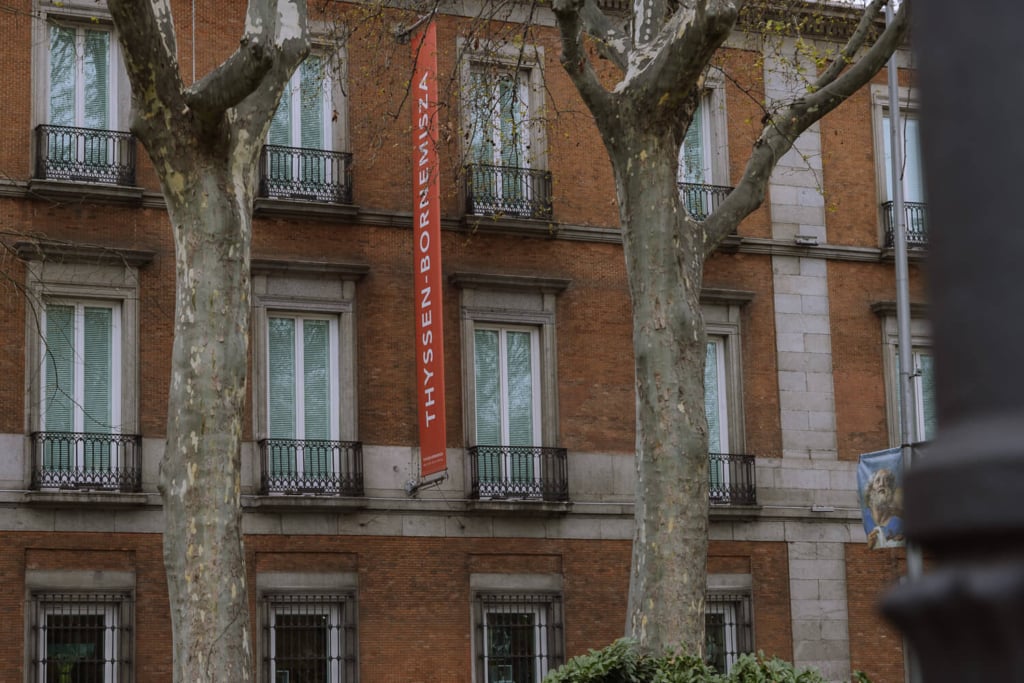
12. PRADO MUSEUM
The Prado Museum is the main national art museum in Spain. It contains the world’s most comprehensive collection of Spanish paintings.
There are around 20,000 works from the 12th to the 13th century and the Prado is widely considered to be the finest collection of European art in the world.
It includes the most complete works of El Greco, Velázquez, and Francisco de Goya. You’ll also find important masters including Zurbarán, Raphael, Tintoretto, and Peter Paul Rubens to name just a few.
Tickets – To avoid the queue, we recommend getting your skip-the-line ticket in advance.



13. REINA SOFÍA MUSEUM
The Museo Nacional Centro de Arte Reina Sofía is the national Spanish museum for 20th-century art. It features contemporary works from some of the country’s leading artists.
Opening in 1990, the museum was considered an important step in Spain’s transition to democracy.
The most famous work is Guernica. The colossal piece by Pablo Picasso depicts the suffering experienced during the Spanish Civil War.
Their other prized possession is The Great Masturbator, the psychic snapshot of life as seen by 25-year-old Salvador Dalí.
It’s a massive collection and one of our favourites in Madrid. They have interesting temporary exhibitions and installations so there’s always a reason to go even if it’s not your first trip to Madrid.
Tickets— Reina Sofia is free from 7 pm to 9 pm weekdays and Saturdays, and 12:30 pm to 2:30 pm Sundays. At all other times, book skip-the-line tickets.




IMPORTANT TIP
MADRID ART WALK PASS
If you plan on visiting all three major art galleries in Madrid (Thyssen-Bornemisza, Prado and Sofia Reina) you should buy the Art Walk Pass which is €32 and includes skip-the-line access to all 3 galleries.
Purchase your Art Walk Pass here.
14. RETIRO PARK
Spread over 125 hectares in central Madrid, El Retiro Park is a green oasis in the centre of the city. Recently named a UNESCO World Heritage Site, the park is a beautiful place to unwind in Madrid.
There are grassy fields, open-air cafes, tree-lined pathways, and romantic gardens. You’ll also find a variety of landscape styles on display as well as ornate statues and dreamy fountains. Here are some of the attractions –
- Estranque – The large artificial lake is the central focus of the park.
- Monument to King Alfonso XII – The massive monument beside the lake is dedicated to Spain’s favourite monarch. On the weekends, you’ll find musicians gathered on the steps.
- Palacio de Cristal – The famous glass palace was constructed in 1887 to house exotic plants for an exhibition from the Philippines.
- Palacio de Velázquez – Located beside the Crystal Palace, The Velázquez Palace is an exhibition space featuring displays from Reina Sofia.
- El Angel Caído – The Fallen Angel statue is a sinister work featuring the moment Lucifer is cast out of heaven.
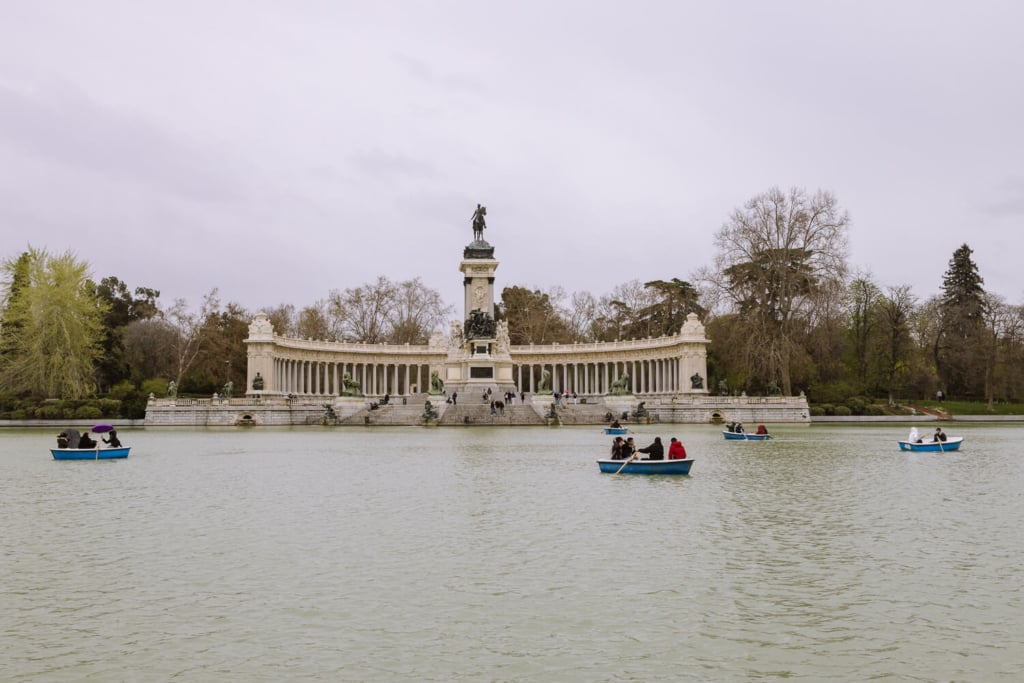


15. EL RASTRO FLEA MARKET
The El Rastro Flea Market spirals out from its central hub around Plaza de Cascorro. The market fills the streets with treasures from over 1,000 stalls. It’s a local institution in Madrid and a great way to feel like you’re no longer a visitor.
The main section is the triangle formed by Calle de Toledo, Calle de Embajadores and Ronda de Toledo.
The side streets contain a host of treasures, and you can find everything from trading cards to antique furniture, second-hand vinyl to vintage cameras.
The surrounding neighbourhood has generation-old tapas bars and creaking restaurants. Try the tiny Ruda Café for great coffee and snacks. For something more substantial, the Toastadas at El Caprichio Extremeño are a Sunday staple.




16. BASILICA DE SAN FRANCISCO EL GRANDE
The Basilica of Saint Francis the Great is a visual masterpiece and a homage to Spanish art.
It doesn’t give too much away from the exterior, but inside, a round floor plan is crowned with a huge 33-metre dome. The marble and gold inlaid chapels contain an incredible collection of art from Spanish masters.
It’s one of the most beautiful churches in the world.
There are 3 chapels featuring paintings by Zurbarán. But, the most famous work is the magnificent painting by Francisco Goya, St Bernardino of Siena preaching to Alfonso V of Aragon.
Tickets – Entry is €5 (€3 for seniors or children), however, it’s free all day Thursday.



17. CHUECA
Chueca is a lively neighbourhood in the heart of Madrid. It’s known for its diversity, gay-friendly venues, cozy pavement cafes, tapas bars and vibrant street art.
It’s a great destination for a night out in Madrid with traditional Spanish restaurants and some of the best bars and clubs in town.
For dinner try either El Social or Josefita. Both are atmospheric, tiny Spanish restaurants with great wine lists. They both have some excellent regional dishes.
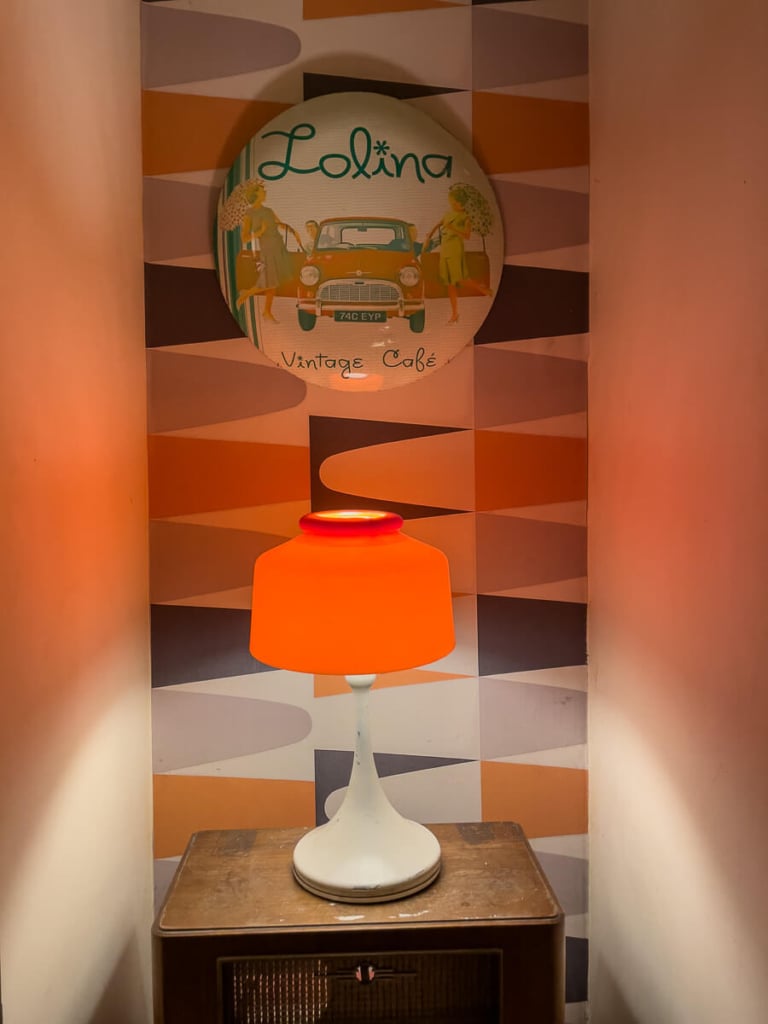

MORE THINGS TO DO IN MADRID
Madrid is bursting with world-class attractions. If you have the time, here are a few more great things to check out.
SANTIAGO BERNABÉU STADIUM
Santiago Bernabéu Stadium is the home stadium of Real Madrid. It has a capacity of over 80,000 visitors and it’s one of the most famous football grounds in the world.
Take a guided tour of the stadium to learn about the history of the club, admire club memorabilia, and take in panoramic views of the stadium.
ATOCHA TRAIN STATION
Madrid Puerta de Atocha was the first train station in Madrid. The historic steel and glass building is one of the city’s best-known landmarks.
The interesting thing about the station is the tropical garden situated under the original train shed. It has over 7,000 plants, making it a great photo opportunity in Madrid. There are bars and restaurants overlooking the garden.

PALACIO DE LIRIA
Palacio de Liria is a neoclassical palace often considered the little brother of the Real Palace. It’s the official residence of the Alba family who have an ancient lineage, closely linked to Spanish history.
The building is protected under Spanish Heritage law. The library contains the first edition of Don Quixote. See it on a guided tour of Palacio de Liria.
PUERTA DEL SOL
Puerta del Sol marks kilometre zero for the Spanish road system. It’s the symbolic centre of the city and one of the busiest places in Madrid.
The large public square has witnessed historical events, the most notable was the proclamation of the 2nd republic. Today, it’s a very popular tourist destination and one of the great free things to do in Madrid.

TEATRO ROYAL
The Royal Theatre is located opposite the Royal Palace and it is considered one of the top institutions for performing arts in Spain.
It has a whopping stage area of 1,472 m2 which allows for very complex set changing. Seeing a performance here is an amazing experience. Check out what’s on at teatroreal.es. Even if you’re not, from the outside, it’s a beautiful building to stop and admire.
PALACIO DE CIBELES
The Communications Palace is a monumental building and the headquarters for the Madrid City Hall. In 1993, it was declared an Asset of Cultural Interest.
The square the building sits on, Plaza de Cibeles, is the most famous in Madrid. It’s at the intersection of Calle de Alcalá, Paseo de Recoletos, and Paseo del Prado, with several beautiful buildings surrounding it.
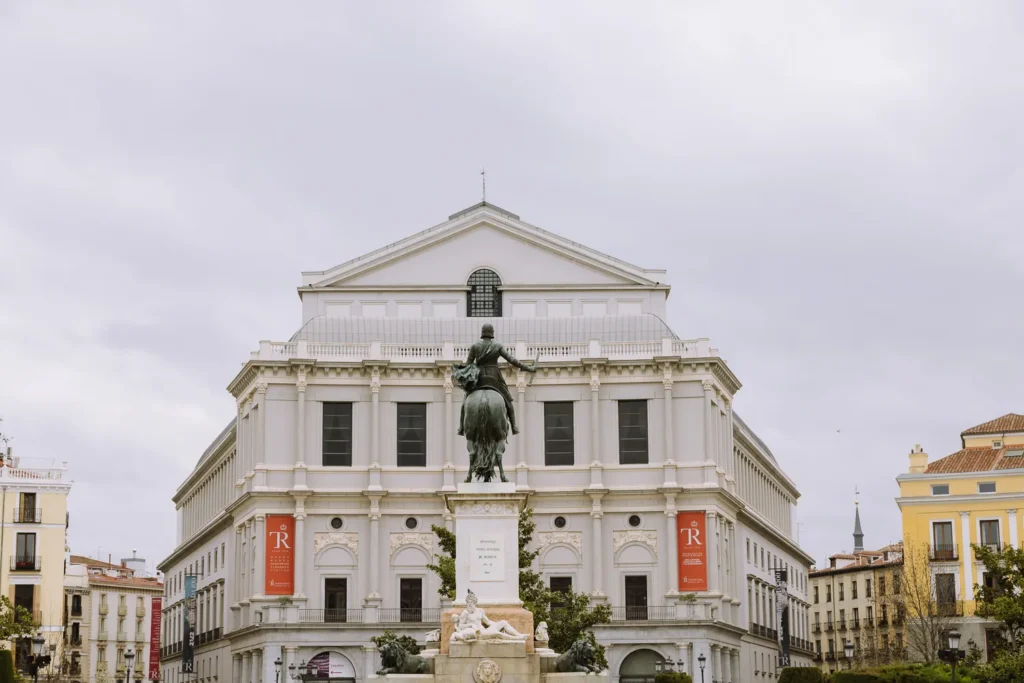

WHERE TO STAY IN MADRID?
The most popular areas for tourists are around the city centre (Sol, Gran Vía, and Opera). Each are well located for the main attractions and nightlife.
The Malasaña neighbourhood is a trendy and bohemian area with great restaurants, bars, and street art. Chueca is another popular neighbourhood known for its LGBT-friendly atmosphere and lively nightlife.
For a more upscale experience, the Salamanca neighbourhood is a great option with high-end shopping and dining options.
OUR PICK
LAS LETRAS / LUXURY
GRAN HOTEL INGLÉS
The Gran Hotel Inglés is the place to go for an indulgent stay in Madrid. With Art Deco design blended with the building’s traditional character and a deluxe spa, you won’t want to leave.
CENTRO / HOSTEL +
WOOHOO SUITES MADRID
Woohoo Suites has both hostel rooms and hotel suites in an excellent location just off Gran Vía. The hotel rooms and small but stylish and the hostel has rooms and dormitories with private and shared bathrooms.
MALASAÑA / FASHIONABLE
7 ISLAS HOTEL
The family-run 7 Islas Hotel is a stylish and affordable option in one of the best neighbourhoods of Madrid. Natural materials create a striking yet welcoming vibe and the amenities are first-class. Don’t skip the cocktails.
CHUECA / BOUTIQUE
PETIT PALACE CHUECA
Part of a chain of boutique hotels in Madrid, Petit Palace Chueca is a moderately priced yet chic property in a grand building near Gran Via. Some rooms have large terraces overlooking the boulevard.


HOW MANY DAYS IN MADRID?
We would recommend spending at least 3 – 4 days in Madrid to get a good taste of the city’s culture, history, and food.
This will allow enough time to visit some of the main attractions like the Prado Museum, Retiro Park, and the Royal Palace, as well as enjoy some of the local food and nightlife.
If you have more time, you can explore the city’s different neighbourhoods, visit more museums, or take day trips to nearby towns and cities.
BEST TIME TO VISIT MADRID
The best time to visit Madrid is over the shoulder seasons of spring (March to May) and autumn (September to November). However, Madrid has both excellent museums and beautiful outdoor spaces, so it’s one of those rare European cities that you could enjoy any time of year.
Spring is a beautiful time to visit Madrid when the weather is mild, the city is in bloom and it’s not yet experiencing the peak tourist season.
From September to November the temperatures begin to cool down again so it’s the ideal time for sightseeing and outdoor activities. The food markets will also be in full swing.



MORE SPAIN GUIDES
- Find all our Spain travel guides.
- Enjoy the best of the Andalusía capital with our guide to must-see attractions in Seville.
- Our guide to Malagá covers your sun-drenched Mediterranean vacation.
- Discover the remarkable Moorish history of the best things to do in Córdoba.
- See northern Spain with our Picos de Europa road trip itinerary.
- Our guide to the best places to visit in Andalucía includes charming villages, great beaches and historic cities.
- See one of the most iconic buildings in the world in our guide to Granada.
- How to hike the Ruta del Cares trail.
- Enjoy the quirky island city relaxed charms of Cádiz, Spain.
- Take a road trip with our White Villages Andalucía driving route.

READER-SUPPORTED
When you buy through links on our site, we may earn a small affiliate commission at no extra cost to you.
Thanks for your support. Paul & Mark

